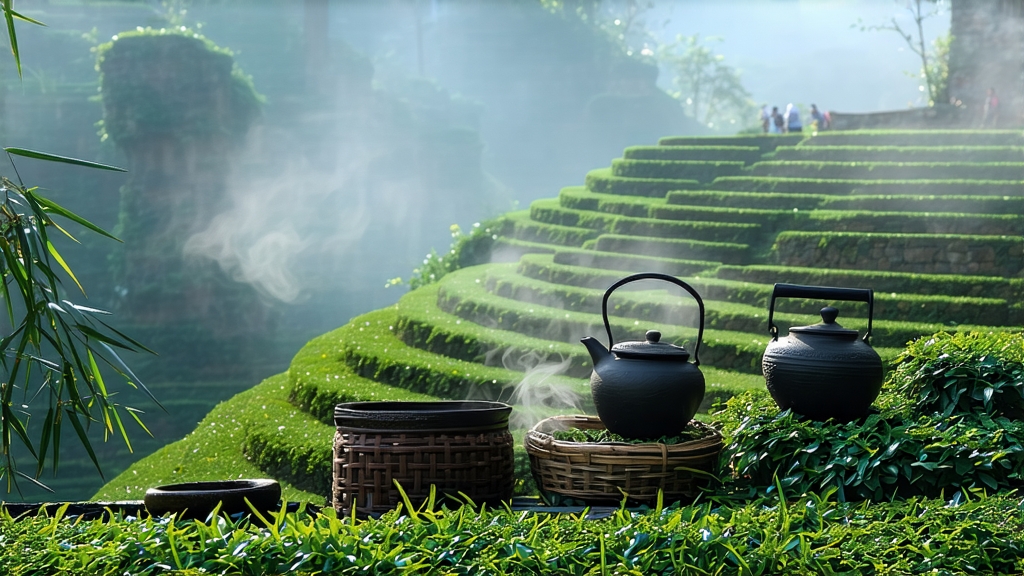
Tucked away in the humid, karst-pocked mountains of southern China’s Guangxi Zhuang Autonomous Region, Liu Bao tea has spent four centuries quietly perfecting the art of transformation. To the casual observer it is merely another dark brick, but to the initiated it is a living chronicle of trade routes, minority craftsmanship and microbial alchemy. While Pu-erh has become the global shorthand for Chinese fermented tea, Liu Bao remains its humbler, older cousin—less swagger, more soul. This article invites the international reader to discover why Liu Bao was once the currency of overseas coolies, how a single bamboo basket can steer the flavour of an entire vintage, and what to listen for when the liquor finally speaks.
-
From War-Horse Trail to Maritime Silk Road
The story begins in the small county of Cangwu, Wuzhou prefecture, where the Liu Bao village gave the tea its name. During the late Ming dynasty (17th c.) the Qing government needed horses for frontier defense; Guangxi farmers needed salt. The barter route known as the “Ancient Tea-Horse Road” thus funneled compressed Liu Bao northward in exchange for Tibetan stallions. By the Qing Qianlong era (1736-1795) the tea had reached the Pearl River Delta and was loaded onto junks bound for Southeast Asia. In the tin mines of Malaya and the rubber plantations of Borneo, Liu Bao became the daily ration of coolies: cheap, stomach-settling, and reputedly able to ward off malaria. Dock manifests from Singapore (1888) list “Liu-pak” alongside opium and rice, proof that the tea had become a colonial commodity. When the overseas Chinese eventually returned home, they brought back a taste for deeper, mustier flavours; the market responded by aging the tea longer, laying the groundwork for the modern vintage paradigm. -
Terroir: Where the Rivers Smell of Ferns
Guangxi’s climate is subtropical monsoon: 1,500 mm of rain annually, 78 % average humidity, red lateritic soil rich in iron and aluminum. The tea gardens sit between 200–600 m on granite-derived slopes drained by the Liu River and its tributaries. Native vegetation includes camphor, Chinese bayberry and tree ferns whose spores ride every breeze. These airborne microbes—Bacillus, Aspergillus, Penicillium—are the silent workforce that will later colonise the tea leaves. Cultivars are exclusively small-leaf Camellia sinensis var. sinensis, locally called “medium-leaf type,” prized for a high ratio of stem to blade; the stems act as capillaries during wet piling, conducting oxygen and moisture. -
Craft: The Bamboo Basket Ritual
Liu Bao is not merely oxidised; it is fermented twice—once by enzymes, once by microbes. The sequence, codified in 1958 but rooted in folk memory, unfolds over six moons:
a) Pluck & Wilt: One bud plus third or fourth leaf, picked after Qingming when amino acids peak. Sun-wilt for 40 minutes until leaf edges feel like suede.
b) Kill-Green: A 5-minute tumble in a 200 °C drum halts oxidation at 55 %, preserving catechins for later microbial feeding.
c) Rolling: A 30-minute low-pressure roll ruptures 35 % of cell walls; the remaining 65 % will be broken by microbes, creating layered texture.
d) First Drying: 80 °C oven until moisture drops to 12 %. The crude tea, called maocha, smells like baked sweet potato.
e) Wet Piling (渥堆): The signature step. Maocha is sprayed with 28 °C river water (pH 6.4), heaped 70 cm high, covered with jute sacks, and left for 25–35 days. Every three days the pile is turned by barefoot workers who listen for the “pop” of gas pockets—an audible cue that thermophilic bacteria are active. Temperature is kept below 60 °C to prevent over-caramelisation.
f) Re-Basket Fermentation: Unique to Liu Bao. The post-pile tea is steamed for 20 seconds, then packed into 40 kg bamboo baskets woven from Qiongzhuea tumidissinoda